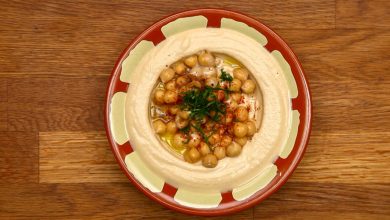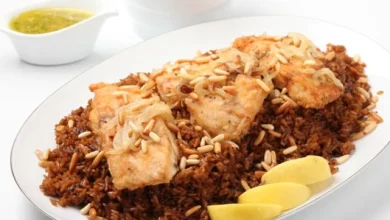Introduction
Maqloubah, meaning “upside-down” in Arabic, is one of the most iconic dishes in Palestinian and broader Levantine cuisine. This rice-based dish, often layered with vegetables and meat, has a deep cultural significance and has become a staple of celebrations, gatherings, and daily family meals. Maqloubah is a harmonious blend of aromatic spices, succulent meat, and tender vegetables, all cooked to perfection and flipped upside down before serving to reveal a beautifully layered masterpiece. In this comprehensive guide, we will explore the history, variations, step-by-step instructions, and nutritional breakdown of this beloved dish.
History and Cultural Significance
Maqloubah has been a cherished dish for centuries, with origins deeply rooted in the Levantine region, specifically Palestine, Jordan, and Syria. Traditionally, Maqloubah is prepared in large quantities to serve families and guests, making it a symbol of hospitality and warmth. While there are regional variations in ingredients, the core idea of layering rice, meat, and vegetables remains consistent.
Ingredients
Meat
Typically, lamb or chicken is used, although beef is also a popular alternative. The choice of meat depends on personal preference, availability, and regional variations. The meat is often marinated with spices to enhance the flavor.
Vegetables
Eggplant is the most common vegetable used in Maqloubah, but cauliflower, potatoes, carrots, and tomatoes can also be included, depending on the variation of the dish.
Rice
Long-grain rice, usually Basmati or Egyptian rice, is the foundation of Maqloubah. The rice absorbs the flavors of the meat, vegetables, and spices during the cooking process.
Spices
The spice mix in Maqloubah includes a range of fragrant and warm spices. Common spices include cinnamon, allspice, turmeric, cardamom, and black pepper.
Recipe for Palestinian Maqloubah
Ingredients Table
| Ingredient | Quantity | Details |
|---|---|---|
| Chicken (or lamb) | 1 kg | Cut into large pieces, bone-in preferred |
| Rice (Basmati or Egyptian) | 2 cups | Soaked in water for 30 minutes |
| Eggplant | 2 large | Sliced into rounds |
| Cauliflower | 1 medium | Cut into florets |
| Potatoes | 2 large | Sliced into rounds |
| Tomatoes | 2 large | Sliced into rounds |
| Onion | 1 large | Sliced |
| Garlic | 4 cloves | Minced |
| Vegetable oil | ½ cup | For frying vegetables |
| Ground cinnamon | 1 tsp | |
| Ground allspice | 1 tsp | |
| Turmeric | 1 tsp | |
| Ground cardamom | ½ tsp | |
| Salt | To taste | |
| Black pepper | To taste | |
| Bay leaves | 2 | |
| Water or broth | 4 cups | |
| Pine nuts (optional) | ¼ cup | Toasted, for garnish |
| Parsley (optional) | ¼ cup | Chopped, for garnish |
Instructions
Step 1: Preparing the Vegetables
- Frying the Vegetables:
- Heat the vegetable oil in a large frying pan over medium heat.
- Fry the eggplant slices until golden brown on both sides. Remove and drain on paper towels.
- In the same oil, fry the cauliflower florets until they are golden. Remove and drain.
- Fry the potato slices until lightly golden. Remove and drain on paper towels.
Step 2: Preparing the Meat
- Cooking the Chicken (or Lamb):
- In a large pot, sauté the onion slices in a bit of oil until softened.
- Add the chicken or lamb pieces and cook until browned on all sides.
- Add the minced garlic and continue cooking for 2-3 minutes.
- Season the meat with cinnamon, allspice, turmeric, cardamom, salt, and pepper.
- Add 4 cups of water or broth and bay leaves to the pot. Bring to a boil, then lower the heat and simmer for 40-50 minutes until the meat is fully cooked and tender.
- Once the meat is cooked, remove it from the broth and set it aside. Strain the broth and reserve it for cooking the rice.
Step 3: Assembling the Maqloubah
- Layering the Pot:
- In a large deep pot, begin layering the ingredients. Start by placing the cooked chicken (or lamb) pieces at the bottom.
- Next, layer the fried vegetables over the meat. Start with the eggplant, followed by cauliflower, potatoes, and tomato slices.
- Finally, top the vegetable layers with the soaked and drained rice.
- Cooking the Rice:
- Gently pour the reserved broth (or water) over the rice. The liquid should cover the rice by about 1 inch. If needed, add more water or broth.
- Bring the pot to a boil over high heat, then reduce the heat to low, cover the pot, and let the Maqloubah cook for 30-40 minutes, or until the rice is fully cooked and has absorbed all the liquid.
Step 4: Flipping and Serving the Maqloubah
- Flipping the Pot:
- Once the rice is cooked, remove the pot from heat and let it rest for 10 minutes.
- Place a large serving platter over the pot. Holding both the pot and the platter firmly, flip them upside down. Gently tap the pot to release the Maqloubah onto the platter.
- Carefully lift the pot to reveal the layered Maqloubah.
- Garnishing and Serving:
- Garnish the Maqloubah with toasted pine nuts and chopped parsley if desired.
- Serve the Maqloubah with a side of yogurt or a fresh salad.
Nutritional Information
Nutritional Breakdown Table (Per Serving)
| Nutrient | Amount | Daily Value (%) |
|---|---|---|
| Calories | 450 kcal | |
| Protein | 25g | |
| Total Fat | 18g | |
| Saturated Fat | 4g | |
| Cholesterol | 70mg | |
| Carbohydrates | 55g | |
| Dietary Fiber | 6g | |
| Sugars | 4g | |
| Sodium | 650mg | |
| Vitamin A | 15% | |
| Vitamin C | 20% | |
| Calcium | 8% | |
| Iron | 15% |
Note: The nutritional information may vary slightly based on the type of meat used and the quantity of oil absorbed during frying.
Variations of Maqloubah
- Vegetarian Maqloubah: Substitute the meat with additional vegetables such as zucchini, carrots, and bell peppers. The spices and broth can remain the same, using a vegetable broth instead of meat broth.
- Beef Maqloubah: Beef can be used instead of chicken or lamb. The beef should be cooked until tender, similar to lamb, and seasoned with the same spices.
- Seafood Maqloubah: In coastal regions, seafood, such as shrimp or fish, is sometimes used. The process remains the same, but the broth and cooking times will vary based on the seafood used.
- Cauliflower Maqloubah: For a lighter version, focus on cauliflower as the primary vegetable, eliminating or reducing the eggplant and potatoes.
Cooking Tips and Tricks
- Frying Alternatives: If you prefer a healthier version of Maqloubah, you can roast the vegetables instead of frying them. Simply brush the vegetables with olive oil and bake them in the oven until golden brown.
- Soaking the Rice: Soaking the rice before cooking helps it cook evenly and absorb the flavors from the broth.
- Flipping the Maqloubah: Letting the pot rest for 10 minutes before flipping helps ensure that the layers stay intact when the dish is inverted onto the platter.
- Serving Suggestions: Maqloubah is often served with a side of plain yogurt or a simple cucumber and tomato salad dressed with lemon juice and olive oil.
Conclusion
Palestinian Maqloubah is more than just a dish; it is a culinary experience that brings together flavors, textures, and aromas in a visually stunning presentation. Whether you’re making the traditional lamb version or experimenting with seafood or vegetarian alternatives, Maqloubah is sure to impress both family and guests alike. The combination of perfectly spiced rice, tender meat, and flavorful vegetables, all flipped upside down in a single dramatic motion, makes this dish a true centerpiece of any meal. Now that you have the complete guide with detailed instructions, ingredients, and nutritional information, you can confidently prepare this beloved dish and share a taste of Palestinian culture with your loved ones.















